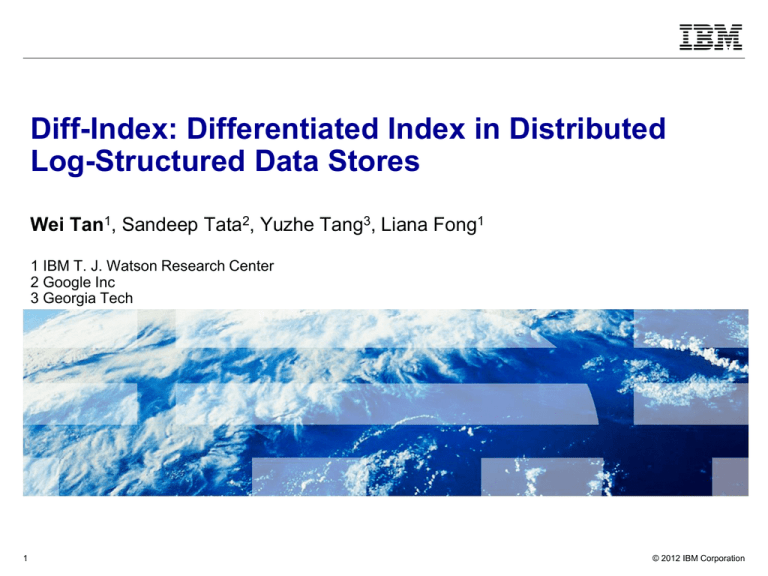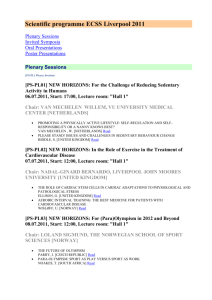Diff-Index
advertisement

Diff-Index: Differentiated Index in Distributed Log-Structured Data Stores Wei Tan1, Sandeep Tata2, Yuzhe Tang3, Liana Fong1 1 IBM T. J. Watson Research Center 2 Google Inc 3 Georgia Tech 1 © 2012 IBM Corporation Agenda Background: NoSQL, LSM and HBase Diff-Index schemes ACID properties System Performance Related work & Summary 2 © 2012 IBM Corporation Background Schemes ACID System Performance Background: Apache HBase HBase is a widely used NoSQL store – Table-like and flexible schema, scale-out on commodity HW, integration with Hadoop – Use log-structure and good for high ingestion rate workload Gap: HBase is slow for ad hoc queries –Has no secondary index; query w/ table scan Two options for index in a partitioned data store like HBase – Global • index on entire table, partitioned on its own • no need to broadcast good for selective queries – Local • one index co-located with each partition • need broadcast queries to each partition costly; update fast, though 3 © 2012 IBM Corporation Background Schemes ACID System Performance [O'Neil, Acta Informatica’96] Log Structure Merge (LSM) Trees memory memory Mem Store Write (sub ms) Mem Store’ Read (~10ms) merge disk Commit log C1 C2 v3 (memstore disk store) Fast B+tree (RDB) v1 C1 v2 C2 C3 Flush LSM Tree = a in-memory store + several on-disk stores compact (merge disk stores) Writes go to a commit log (seq. IO) and inmemory store – update not in-place, FAST reads Commit log’ disk memory Mem Store’ LSM tree (HBase) Memstore periodically pushed to disk Slow Reads go to mem+disk storeslogging (random IO)- SLOW Slow periodically compacted Fast On-disk stores to save spacewrite/inserts & speedup read 4 disk Commit log’ C1’ V1,2,3 © 2012 IBM Corporation Background Schemes ACID System Performance HBase architecture Records range partitioned into regions Each region stores data in LSM Used in Facebook, Meetup, Splice Machine, … 5 © 2012 IBM Corporation Background Schemes ACID System Performance Challenges of index maintenance in LSM 1. Log Structured Merge tree: a reviving interest in it a) Write workload 10~20% > 50%: click streams, sensors, mobile… b) With non in-place update and slow read, index update can be slow 2. Distributed systems a) Distributed index maintenance needs coordination b) Performance/consistency tradeoff: CAP theorem 1 LSM Tree 3. Failure recovery: adding another log? 3 failure recovery 2 CAP Diff-Index -- differentiated secondary Index a global index scheme on LSM-Tree with balanced performance and lightweight failure recovery cost 6 © 2012 IBM Corporation Background Schemes ACID System Index update operations in LSM Stars 3 4 Task: index review by stars Both data and index are stored as HBase tables Key/Value Data table (Review) Index table (ReviewByStar) Rev1/5, t2 Performance ReviewID Rev1 Rev2 Text … … ReviewID Rev1 Rev2 Stars 3 4 … … … Rev1/3, t1 Rev2/4, t1 Start from an empty table, at time t1 – Insert two new reviews -- Rev1 and Rev2 – Insert two index records for Rev1 and Rev2 5/Rev1, t2 At a later time t2: change the star of Rev1 to 5 – HBase has only one put() API for insert and update -different from RDBMS & SQL – Insert <Rev1/5> auto-invalidates <Rev1/3> -- t1 < t2 – Index record insert: <5/Rev1> – <5/Rev1> does NOT invalidate stale index <3/Rev1> 3/Rev1, t1 4/Rev2, t1 Vanilla solution: read data table to get old value (“3”) and delete index <3/Rev1> index_update = insert + read + del (read is costly!) Tune the above equation to shorten the latency (see next slides)? 7 © 2012 IBM Corporation Background Schemes ACID System Index schemes by revisiting the equation: index_update = insert + read + del Put a new <k/v’> when an old <k/v> exists (think of k as ReviewID, v as Star in Yelp) ReviewID R00001 … Text … … Stars 5 … … … … 8 Data k/v’ k/v Index v’/k v/k 1. sync-full: read data tbl to get old value “v”; del index <v/k> using it sync-full = insert + read + del Data k/v’ k/v 2) Find k is not with “v”; Data k/v’ k/v Index v’/k v/k 1) Query “v” and get “k” 3) Del “v/k” Index v’/k v/k 2. sync-insert: let old (<v/k>) in index; lazy clean: only when a query uses it sync-insert = insert Performance 3. async: add (insert + read + del) into asynchronous update queue (AUQ) async = 0 (insert + read + del) © 2012 IBM Corporation Background Schemes ACID System Performance Operation complexity analysis of Diff-Index schemes method no-index 1 sync-full 2 sync-insert 3 async index operation data insert update 1 read -update 1 read 0 update 1 read 0 update 1 read 0 sync-full = insert + read + del sync-insert = insert async = 0 (insert + read + del) 9 data read index insert index read 0 0 0 ---1 1+1 0 0 0 1 0 1 0 M (M) 1 1 (Def.) 1+1 (Def.) 0 0 0 1 Operation update=put a record into HBase Operation read=point query with index access only Def.=deferred M=#rows matching the search key © 2012 IBM Corporation Background Schemes ACID System Performance Session consistency: read-your-own-write A fine tuning of async = 0 (insert + read + del) async-session Recall the Yelp example timeline Cannot Can seesee R01R01 User 1 t1.View reviews for business A t2.Post review for business A t3.View reviews for business A Session cache “local” to a user Cannot see R01 User 2 t1.View reviews for business B t3.View reviews for business A BusinessID ReviewID A R01 … … BusinessID ReviewID … … … … BusinessID ReviewID … … … … async ReviewID R01 … 10 Text … … Stars 5 … UserID U1 … BusinessID A … © 2012 IBM Corporation Background Schemes ACID System Performance ACID properties Atomicity – Individual operations PB, PI, RB, DI, are atomic Consistency – Sync-full and sync-insert: causal consistent – If any of PI, RB, DI fails, causal consistent eventual consistent by AUQ Isolation: read committed Durability – Guaranteed by WAL and AUQ failure handling protocol 11 IBM Confidential © 2012 IBM Corporation Background Schemes ACID System Performance Failure recovery for Asynchronous Update Queue (AUQ) Index update fails in sync- or async- schemes – Append failed operation to AUQ: casual consistent eventual consistent What if AUQ fails, e.g., during a server failure? – Option 1: add a log to AUQ – Option 2: leverage the Write-ahead-Log (WAL) of base table put 1 Durability is guaranteed if WAL Enforce 3.0 before 3.1 flush 3.2 roll-forward Replay index update after WAL replay Index uses base’s timestamp 2.1 MemTable 3.1 flush HTable HBase 3.0 pause & drain AUQ Diff-Index 2.2 12 AUQ x 4 PI, RB, DI Index tables PI: insert index RB: read base DI: delete index © 2012 IBM Corporation Background Schemes ACID System Performance Diff-Index system: global, server-managed index with configurable schemes Function and performance testing Client query API; index mgt Client Library YCSB 0.14 TPC-W table Index Utility (create, destroy, bulk load, cleanse) getByIndex API Regions Coprocessors Data Table AsyncObserver Session cache SyncFullObserver failure index put SyncInsertObserver AUQ DDL: define indexes Catalog: store index def. Query engine: use index BigSQL/BigInights DDL, Catalog, query engine … Index Table Regions Async Sync 13 [In IBM InfoSphere BigInsights v2.1] © 2012 IBM Corporation Background Schemes ACID System Performance Performance of index update data update only; 1x 14 sync-full = insert + read + del high >5x sync-insert = insert ~2x async = 0 (insert + read + del) low and grows with load © 2012 IBM Corporation Background Schemes ACID System Performance Performance of index read You can trade read for update, or vice versa Performance of index update Fast Slow due to double check As fast as sync-full but inconsistent 15 © 2012 IBM Corporation Background Schemes ACID System Performance Consistency in async: index-after-data time lag Measure the distribution of the time-lag, under different transaction rate 600 throughput (TPS) 1500 2000 2700 3000 4000 100% 90% 80% 70% cumulative distribution <100 ms 60% >100 s 50% 40% 30% 20% 10% 0% 1 4 7 10 40 70 100 400 700 1000 4000 7000 10000 40000 70000 100000 400000 index staleness (ms) 16 Staleness of async index grows with tranx rate of the system async = 0 (insert + read + del) © 2012 IBM Corporation Background Schemes ACID System Performance Diff-Index schemes: experiments coherent with analysis Scheme Feature 1 Sync-full 2 Syncinsert 3 Asyncsession 4 Async Update latency High Medium Low Low Read latency Low High/Low Low Low Consistent read Yes Yes/No No/Session No Better consistency 17 Better (update) performance © 2012 IBM Corporation Related Work HBase index – Salesforce Phoenix: global index • Has only “sync-full” scheme • Kill region server when index update fails (vs. drop to AUQ) – Huawei: local index Transactions in NoSQL – Percolator: 2PC in BigTable – Spanner: 2PC + Paxos + GPS TrueTime – OMID: check R-W (instead of W-W) conflicts to ensure serializability LSM – bLSM: a better LSM compaction scheduler + BloomFilter 18 IBM Confidential © 2012 IBM Corporation Summary and future work Diff-Index –Consistency configurable index for HBase –Lightweight failure recovery by exploiting LSM features –Other product features • Indexing row key/indexing dense column/composite index • Incremental index maintenance Future work – Enhance consistency and isolation, e.g., using Percolator or OMID protocol – Workload-aware scheme selection 19 © 2012 IBM Corporation Backup slides 20 IBM Confidential © 2012 IBM Corporation Background Schemes ACID System Performance Range query latency: with different selectivity (i.e., how many records returned by it) low latency Double check can be costly 21 © 2012 IBM Corporation Motivation Challenge Diff-Index System Performance The basic idea behind Diff-Index: CAP Theorem CAP theorem: achieve two out of three in a dist env C: consistency A: availability (latency) P: partition tolerance Higher latency Fewer inconsistencies Lower latency More inconsistencies Eventual Serializable per-key sequential (HBase out-of-box) 22 Diff-Index: schemes to balance performance & consistency for LSM-Tree index , by tuning the equation: index_update = insert + read + del © 2012 IBM Corporation
